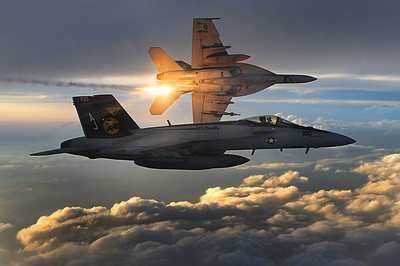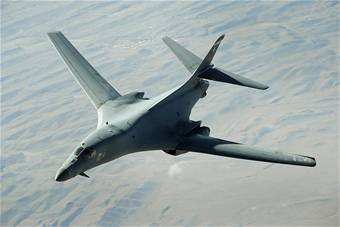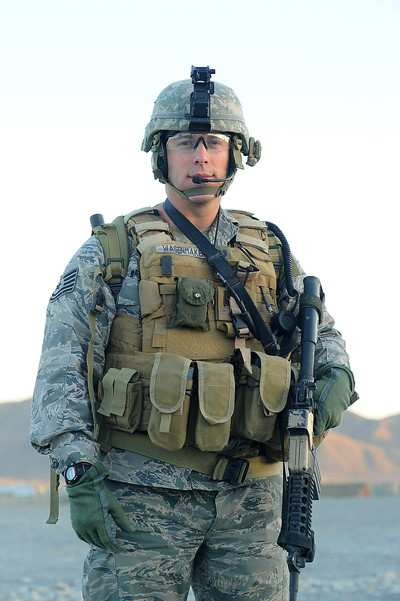Controllers Help Guide Precision Munitions
inimizing collateral damage is at the forefront of military
leaders' priorities in Afghanistan. Those leaders depend on the
teamwork between pilots and Air Force joint terminal attack
controllers to ensure innocent civilians and their property aren't
put at unnecessary risk.

By combining laser-guided munitions with constant communication
between JTACs on the ground and pilots in the sky, collateral
damage is kept at the lowest possible level.
"Preventing civilian casualties and [friendly fire] is our
primary concern," said Master Sgt. Leigh Bradley, JTAC
superintendent from the 19th Expeditionary Air Support Squadron.
"The Air Force has gone to great lengths in providing precision
strike weaponry that serves this very purpose."
The JTACs serve as liaisons between Army ground commanders and
pilots by planning, communicating and coordinating close-air
support to eliminate enemy threats.
These Airmen have several tools they use to minimize collateral
damage such as published fixed-wing risk estimate distances,
accredited collateral damage estimate charts and flight
restrictions, according to Sergeant Bradley.
 "These efforts provide the ground commander a valid means to
neutralize a target while preserving the lives of friendly forces
and the civilian populace," the 20-year JTAC added.
"These efforts provide the ground commander a valid means to
neutralize a target while preserving the lives of friendly forces
and the civilian populace," the 20-year JTAC added.
While the JTACs rely on their tools, the trust between them and
the pilots serves as one of the most important aspects of close-air
support.
"One major component of the relationship between the JTAC and
the [aircrew] is the trust and understanding of expectations," said
Capt. Daniel Wester, 34th Expeditionary Bomb Squadron weapons
system officer. "The JTAC must trust that the aircrew is going to
strike precisely when and where needed in order to save friendly
lives. The aircrew in turn must trust that the JTAC passed [on] the
right coordinates, properly assessed the threat and mitigated
collateral damage to the [maximum] extent he can.
"This expectation of professionalism results from the trust that
forms from the life-saving interaction between aircrew and JTACs,"
he said.
The pilots know to trust the JTACs because of the exhausting
measures they go through before requesting kinetic weapon
support.
"We do not act on a sole source of intelligence; we collect as
much data as we can gather before employing anything," said Tech.
Sgt. Harvey Wagenmaker, 2-506th Battalion Air liaison officer. "We
have to have enough evidence to determine the [targets] to be
hostile."
The JTACs also estimate the potential collateral damage to
ensure there are no structures, such as schools or mosques that can
be affected by the bombs impact.
"A common misconception is that bombs create a lot of
uncontrolled damage," said Sergeant Wagenmaker, the 13-year JTAC
deployed from Fort Campbell, KY. "But with precision-guided
munitions, our risk-estimated distances and the information we have
on the munition's blast radius, unless something goes severely
wrong, the bomb will hit it's intended point of impact."
It's that sort of confidence in their profession that gives
military leaders the trust in their Airmen to accomplish their
mission while minimizing collateral damage.

"It's a priority every time we drop [munitions]," Sergeant
Wagenmaker said. "The bottom line is we go through extraordinary
measures to ensure there are no civilian casualties."
(Aero-News salutes Staff Sgt. Andrea Thacker, Air Forces
Central News Team)
 Sierra Space Repositions Dream Chaser for First Mission
Sierra Space Repositions Dream Chaser for First Mission ANN's Daily Aero-Term (05.10.24): Takeoff Roll
ANN's Daily Aero-Term (05.10.24): Takeoff Roll Aero-News: Quote of the Day (05.10.24)
Aero-News: Quote of the Day (05.10.24) Aero-News: Quote of the Day (05.11.24)
Aero-News: Quote of the Day (05.11.24) ANN's Daily Aero-Term (05.11.24): IDENT Feature
ANN's Daily Aero-Term (05.11.24): IDENT Feature





